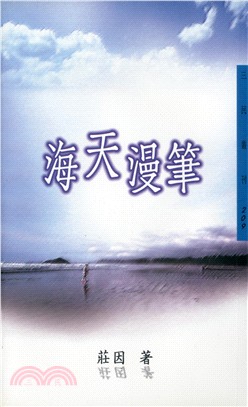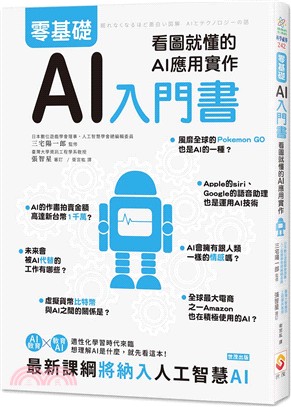相關商品
商品簡介
目次
書摘/試閱
商品簡介
《農業生態學(第二版)》是“國家雙語教學示範課程”配套教材,也是福建農林大學與加拿大戴爾豪斯大學(Dalhousie University)本科教育合作項目(2012年至今)的成果之一。
《農業生態學(第二版)》緊緊圍繞“農業是把太陽光轉變成人們健康、幸福生活的產業”這一在世界農業面臨全面生態化轉型背景下對“農業”的本質過程和根本目標的理解,把“農業生態學”定義為地球演化進入“人類世”的農業系統學科,它既是指導農業生態轉型的一種科學,也是推進農業生態轉型的一種實踐,更是實現全球可持續的食品體系的一種社會運動。為此,《農業生態學(第二版)》主要介紹農業生態學的學科內涵、農業生態系統的基本過程及人為問題,以及可持續農業生產系統的構建與管理等內容。
《農業生態學(第二版)》緊緊圍繞“農業是把太陽光轉變成人們健康、幸福生活的產業”這一在世界農業面臨全面生態化轉型背景下對“農業”的本質過程和根本目標的理解,把“農業生態學”定義為地球演化進入“人類世”的農業系統學科,它既是指導農業生態轉型的一種科學,也是推進農業生態轉型的一種實踐,更是實現全球可持續的食品體系的一種社會運動。為此,《農業生態學(第二版)》主要介紹農業生態學的學科內涵、農業生態系統的基本過程及人為問題,以及可持續農業生產系統的構建與管理等內容。
目次
Contents
Part Ⅰ Context of Agroecology
Chapter 1 Agriculture and Its Anthropocentric Sciences 3
1.1 Introduction and the Anthropocene Era 3
1.2 What Are the “Hot” Issues in Agriculture and Food System? 5
1.3 Agriculture, Agricultural Sustainability, and Agroecology 6
1.4 Corn as a Symbol of Agroecology 14
Chapter 2 Natural Ecosystems Versus Agroecosystems 17
2.1 Expanding Our Understanding of “Ecology” 17
2.2 Natural Versus Agricultural Ecosystems 19
2.3 Energy Flow and Matter Cycle in a Natural Ecosystem 22
2.4 Agroecosystems Harvest the Sun 24
2.5 Matter Cycle and Agroecosystems 25
2.6 Ecological Footprint 26
Part Ⅱ Basics of Agroecosystems
Chapter 3 Soils as the Basis for Cultivated Ecosystems 31
3.1 Introduction 32
3.2 Formation and Classification of Soils 32
3.3 Ecosystem Services Provided by Soils 33
3.4 Soil Characteristics 35
Chapter 4 Water as the Basis for Cultivated Ecosystems 47
4.1 Water Resources in the Global Ecosystem 47
4.2 Water in Agroecosystems 50
4.3 Aspects of Water Management in Agroecosystems 54
Chapter 5 Linking Agroecosystems to Food Systems 57
5.1 Food Systems in Association with Agroecosystem 57
5.2 Agroecological Transition: Making Money and Respecting the Environment 58
5.3 Concept of Sweet Spot 61
5.4 Educating Consumers with Agroecology 61
Chapter 6 Agroecosystem Health and Services 63
6.1 What Is Ecosystem Health and How Does It Relate to Ecosystem Services? 64
6.2 Evaluating Agroecosystem Health and Services 71
Part Ⅲ Digging Deeper into Agroecosystems
Chapter 7 Agroecology and Hunger 79
7.1 Hunger Concepts and Definitions 80
7.2 Causes for Hunger 83
7.3 Green Revolutions 88
Chapter 8 Wastes or Resources in Agroecosystems? 93
8.1 What Are Resources and Wastes in Agroecosystems? 94
8.2 Resources in Agroecosystems 95
8.3 Waste in Agroecosystems 96
8.4 Compost: Making It 98
8.5 Vermicomposting 105
8.6 Agricultural Uses of Compost 105
Chapter 9 Global Climate Change and Agriculture 107
9.1 What Is the Evidence for Climate Change? 107
9.2 What Is the Greenhouse Effect and How Is It Related to Climate Change? 110
9.3 Other Greenhouse Gases 114
9.4 Agriculture’s Contribution to the Greenhouse Gases and Global Climate Change 116
9.5 Impacts of Global Climate Change on Agriculture 117
Chapter 10 Agrobiodiversity and Agroecosystem Stability 123
10.1 Biodiversity and Its Associated Ecosystem Services 123
10.2 Biodiversity in Agroecosystems 128
10.3 Regenerating Biodiversity in Agroecosystems 131
Part Ⅳ Application of Agroecosystem Concepts
Chapter 11 Domestication in Agricultural Systems 141
11.1 Introduction 141
11.2 Adaptations for Wild Species Versus Adaptations for Domesticated Species 142
11.3 How Did Domestication Allow for an Increase in Human Population? 144
11.4 Domestication and Evolution of Agriculture 145
11.5 Is Animal Production Good for Humans and the Planet? 146
11.6 Is Domestication Exploitation? 147
Chapter 12 Animal Welfare: A Good Life for Animals 151
12.1 Introduction 151
12.2 Principal Animal Welfare Issues in Modern Animal Agriculture 152
12.3 Animal Welfare: Observations and Research 154
12.4 Scientific Research 156
12.5 International Approaches to Implementation of Animal Welfare and Their Impacts 160
Chapter 13 Forage-Based Production Systems 163
13.1 Introduction 163
13.2 Forages in Production Systems 164
13.3 Beneficial Effects of Forages 165
13.4 Harvesting and Storing Forage 167
13.5 Forages in Rotations 168
Chapter 14 Cereal-Based Cropping Systems 171
14.1 Introduction: Why Are Seeds of Cereals So Great? 171
14.2 Domestication and Adaptation of Cereals 174
14.3 The Major Cereal Crops in the World 175
14.4 Cropping Strategies with Cereals 178
14.5 Strategies for Improving Cereal Crops to Meet Future Needs 179
Chapter 15 Vegetable-Based Production Systems 181
15.1 The Roles of Vegetable in Human Development 181
15.2 Nutrient Deficiencies 182
15.3 Socioeconomic Impact 183
15.4 Classification Systems of Vegetables 185
15.5 Vegetable-Based Production Systems 187
15.6 Profit Versus Principle 189
Chapter 16 Perennial Fruit and Nut Production Systems 191
16.1 Perennial Woody Plants in Agroecosystems 191
16.2 Economics and Health with Fruit and Nut Crops 193
16.3 Growing Fruits and Nuts 194
16.4 Biotechnology and the Papaya: A Case Study in Hawaii 196
16.5 Almonds and Water: Case Study 197
16.6 Agroforestry and Its Techniques 198
Chapter 17 Aquaculture Production Systems 201
17.1 Aquaculture Must Grow in the Twenty-first Century 201
17.2 The Role of Aquaculture in Human Nutrition 203
17.3 Methods and Energy Efficiency in Finfish Aquaculture 204
17.4 Sustainability of Aquaculture: Global Perspective 208
Chapter 18 Environmental Innovations in Urban Ecosystems 211
18.1 U.......
Part Ⅰ Context of Agroecology
Chapter 1 Agriculture and Its Anthropocentric Sciences 3
1.1 Introduction and the Anthropocene Era 3
1.2 What Are the “Hot” Issues in Agriculture and Food System? 5
1.3 Agriculture, Agricultural Sustainability, and Agroecology 6
1.4 Corn as a Symbol of Agroecology 14
Chapter 2 Natural Ecosystems Versus Agroecosystems 17
2.1 Expanding Our Understanding of “Ecology” 17
2.2 Natural Versus Agricultural Ecosystems 19
2.3 Energy Flow and Matter Cycle in a Natural Ecosystem 22
2.4 Agroecosystems Harvest the Sun 24
2.5 Matter Cycle and Agroecosystems 25
2.6 Ecological Footprint 26
Part Ⅱ Basics of Agroecosystems
Chapter 3 Soils as the Basis for Cultivated Ecosystems 31
3.1 Introduction 32
3.2 Formation and Classification of Soils 32
3.3 Ecosystem Services Provided by Soils 33
3.4 Soil Characteristics 35
Chapter 4 Water as the Basis for Cultivated Ecosystems 47
4.1 Water Resources in the Global Ecosystem 47
4.2 Water in Agroecosystems 50
4.3 Aspects of Water Management in Agroecosystems 54
Chapter 5 Linking Agroecosystems to Food Systems 57
5.1 Food Systems in Association with Agroecosystem 57
5.2 Agroecological Transition: Making Money and Respecting the Environment 58
5.3 Concept of Sweet Spot 61
5.4 Educating Consumers with Agroecology 61
Chapter 6 Agroecosystem Health and Services 63
6.1 What Is Ecosystem Health and How Does It Relate to Ecosystem Services? 64
6.2 Evaluating Agroecosystem Health and Services 71
Part Ⅲ Digging Deeper into Agroecosystems
Chapter 7 Agroecology and Hunger 79
7.1 Hunger Concepts and Definitions 80
7.2 Causes for Hunger 83
7.3 Green Revolutions 88
Chapter 8 Wastes or Resources in Agroecosystems? 93
8.1 What Are Resources and Wastes in Agroecosystems? 94
8.2 Resources in Agroecosystems 95
8.3 Waste in Agroecosystems 96
8.4 Compost: Making It 98
8.5 Vermicomposting 105
8.6 Agricultural Uses of Compost 105
Chapter 9 Global Climate Change and Agriculture 107
9.1 What Is the Evidence for Climate Change? 107
9.2 What Is the Greenhouse Effect and How Is It Related to Climate Change? 110
9.3 Other Greenhouse Gases 114
9.4 Agriculture’s Contribution to the Greenhouse Gases and Global Climate Change 116
9.5 Impacts of Global Climate Change on Agriculture 117
Chapter 10 Agrobiodiversity and Agroecosystem Stability 123
10.1 Biodiversity and Its Associated Ecosystem Services 123
10.2 Biodiversity in Agroecosystems 128
10.3 Regenerating Biodiversity in Agroecosystems 131
Part Ⅳ Application of Agroecosystem Concepts
Chapter 11 Domestication in Agricultural Systems 141
11.1 Introduction 141
11.2 Adaptations for Wild Species Versus Adaptations for Domesticated Species 142
11.3 How Did Domestication Allow for an Increase in Human Population? 144
11.4 Domestication and Evolution of Agriculture 145
11.5 Is Animal Production Good for Humans and the Planet? 146
11.6 Is Domestication Exploitation? 147
Chapter 12 Animal Welfare: A Good Life for Animals 151
12.1 Introduction 151
12.2 Principal Animal Welfare Issues in Modern Animal Agriculture 152
12.3 Animal Welfare: Observations and Research 154
12.4 Scientific Research 156
12.5 International Approaches to Implementation of Animal Welfare and Their Impacts 160
Chapter 13 Forage-Based Production Systems 163
13.1 Introduction 163
13.2 Forages in Production Systems 164
13.3 Beneficial Effects of Forages 165
13.4 Harvesting and Storing Forage 167
13.5 Forages in Rotations 168
Chapter 14 Cereal-Based Cropping Systems 171
14.1 Introduction: Why Are Seeds of Cereals So Great? 171
14.2 Domestication and Adaptation of Cereals 174
14.3 The Major Cereal Crops in the World 175
14.4 Cropping Strategies with Cereals 178
14.5 Strategies for Improving Cereal Crops to Meet Future Needs 179
Chapter 15 Vegetable-Based Production Systems 181
15.1 The Roles of Vegetable in Human Development 181
15.2 Nutrient Deficiencies 182
15.3 Socioeconomic Impact 183
15.4 Classification Systems of Vegetables 185
15.5 Vegetable-Based Production Systems 187
15.6 Profit Versus Principle 189
Chapter 16 Perennial Fruit and Nut Production Systems 191
16.1 Perennial Woody Plants in Agroecosystems 191
16.2 Economics and Health with Fruit and Nut Crops 193
16.3 Growing Fruits and Nuts 194
16.4 Biotechnology and the Papaya: A Case Study in Hawaii 196
16.5 Almonds and Water: Case Study 197
16.6 Agroforestry and Its Techniques 198
Chapter 17 Aquaculture Production Systems 201
17.1 Aquaculture Must Grow in the Twenty-first Century 201
17.2 The Role of Aquaculture in Human Nutrition 203
17.3 Methods and Energy Efficiency in Finfish Aquaculture 204
17.4 Sustainability of Aquaculture: Global Perspective 208
Chapter 18 Environmental Innovations in Urban Ecosystems 211
18.1 U.......
書摘/試閱
Part I Context of Agroecology
Chapter 1 Agriculture and Its Anthropocentric Sciences
S. Wang and C. D. Caldwell
“ but just simply distributing seeds and fertilizer, if that’s the plan, it’s going to fail long term.” —Howard Buffett
Abstract The current model for industrialized agriculture is at a crossroads, characterized by degraded soil and environment, unbalanced human nutrition, food safety issues, loss of trust between consumer and producer, and finally sustainability at risk. By critically reviewing and integrating the definition and technological evolution of agriculture, agroecology links agricultural sciences with ecology to form an interdisciplinary and holistic science, generalized for steering an imperative agroecological transition in this anthropocentric era.
Learning Objectives
After studying this topic, students should be able to:
1. Explain the concept of the Anthropocene Era and why the earth may now be considered a “human planet”.
2. Describe three current important topics affected by how we do agriculture production.
3. Define the terms agriculture, agricultural sustainability, and agroecology.
4. Discuss how the discipline of agroecology has evolved and fits in the philosophy of agricultural sustainability.
5. Describe the three pillars of agricultural sustainability.
6. Explain why corn is a good symbol for the study of agroecology.
1.1 Introduction and the Anthropocene Era
In May 1987, Jared Diamond published an article in Discover Magazine, entitled “The Worst Mistake in the History of the Human Race” in which he puts forward the thesis that agriculture, despite all its apparent positive effects on health, well-being, and survival of human populations, may have been a very negative turning point for humankind. He sees that agriculture has in many ways produced the disaster of social problems, disease and dysfunctional society. Nowadays, we would also add to that list of negatives associated with agriculture, problems of environmental degradation. Whether we agree with Dr. Diamond’s conclusions or not, human needs have certainly reshaped global ecosystems.
Where previously there was a hunter–gatherer society, a drastic change occurred when farming was invented about 10,000 years ago. That is only about 300 generations ago and the world population was 1 million. About 5500 years ago, we developed cities and civilizations and the world population was about 5 million. Along came the Industrial Revolution about 150 years ago and the broader population had reached 1 billion. With World War II and the great acceleration 70 years ago, our population has blossomed. It took 50,000 years to reach the first 1 billion people; the last billion took 10 years.
Technically, geologists would say that we are in the geologic Era called the Holocene. This is the period of the past 10,000 years of reasonably stable climate since the last Ice Age. We learn a lot from looking at layers of rock to determine the past geology of our planet. By examining the fossil record we can see the coming and going of species throughout the ages and speculate on what made some species survive and others not. It is interesting to speculate on what people in the future will tell about our time on this earth. From what we know at the moment, the geology will tell a story of extinct species, changes in the ocean chemistry, fewer forests and more deserts, dammed rivers and retreating glaciers, sunken islands, aluminum drink cans and plastic bottles, and perhaps large evidence of megaprojects like the oilsands in northern Canada. There are some geologists who, considering the present state of the world, would call this new era the Anthropocene; this is in recognition that humans have become geophysical forces with effects as much as asteroids and volcanoes have had in the past.
If we consider that earth is now a “human planet”, we need to consider how agriculture has contributed to this new era. The invention or evolution of agriculture 10,000 years ago was perhaps triggered by climate change at the end of the Ice Age. Warmer, drier conditions were conducive to the growing of cereals (annual grasses) which were extremely successful due to their ease of production, their concentrated nutrition, ease of storage and transportation. This new culture depended on burning, shifting cultivation. However, with the domestication of chickens, pigs, and cows, there was an opportunity for the cycling of nutrients by putting manures back on the ground. This natural fertilizer worked well within such systems. However, as populations concentrated in groups, these natural fertilizers were not enough to avoid the starvation of masses. This led to the invention and widespread use of artificial fertilizers.
The next steps in agriculture included extensive land clearing, increased use of water for irrigation (note that we now use 70% of our freshwater for agric
Chapter 1 Agriculture and Its Anthropocentric Sciences
S. Wang and C. D. Caldwell
“ but just simply distributing seeds and fertilizer, if that’s the plan, it’s going to fail long term.” —Howard Buffett
Abstract The current model for industrialized agriculture is at a crossroads, characterized by degraded soil and environment, unbalanced human nutrition, food safety issues, loss of trust between consumer and producer, and finally sustainability at risk. By critically reviewing and integrating the definition and technological evolution of agriculture, agroecology links agricultural sciences with ecology to form an interdisciplinary and holistic science, generalized for steering an imperative agroecological transition in this anthropocentric era.
Learning Objectives
After studying this topic, students should be able to:
1. Explain the concept of the Anthropocene Era and why the earth may now be considered a “human planet”.
2. Describe three current important topics affected by how we do agriculture production.
3. Define the terms agriculture, agricultural sustainability, and agroecology.
4. Discuss how the discipline of agroecology has evolved and fits in the philosophy of agricultural sustainability.
5. Describe the three pillars of agricultural sustainability.
6. Explain why corn is a good symbol for the study of agroecology.
1.1 Introduction and the Anthropocene Era
In May 1987, Jared Diamond published an article in Discover Magazine, entitled “The Worst Mistake in the History of the Human Race” in which he puts forward the thesis that agriculture, despite all its apparent positive effects on health, well-being, and survival of human populations, may have been a very negative turning point for humankind. He sees that agriculture has in many ways produced the disaster of social problems, disease and dysfunctional society. Nowadays, we would also add to that list of negatives associated with agriculture, problems of environmental degradation. Whether we agree with Dr. Diamond’s conclusions or not, human needs have certainly reshaped global ecosystems.
Where previously there was a hunter–gatherer society, a drastic change occurred when farming was invented about 10,000 years ago. That is only about 300 generations ago and the world population was 1 million. About 5500 years ago, we developed cities and civilizations and the world population was about 5 million. Along came the Industrial Revolution about 150 years ago and the broader population had reached 1 billion. With World War II and the great acceleration 70 years ago, our population has blossomed. It took 50,000 years to reach the first 1 billion people; the last billion took 10 years.
Technically, geologists would say that we are in the geologic Era called the Holocene. This is the period of the past 10,000 years of reasonably stable climate since the last Ice Age. We learn a lot from looking at layers of rock to determine the past geology of our planet. By examining the fossil record we can see the coming and going of species throughout the ages and speculate on what made some species survive and others not. It is interesting to speculate on what people in the future will tell about our time on this earth. From what we know at the moment, the geology will tell a story of extinct species, changes in the ocean chemistry, fewer forests and more deserts, dammed rivers and retreating glaciers, sunken islands, aluminum drink cans and plastic bottles, and perhaps large evidence of megaprojects like the oilsands in northern Canada. There are some geologists who, considering the present state of the world, would call this new era the Anthropocene; this is in recognition that humans have become geophysical forces with effects as much as asteroids and volcanoes have had in the past.
If we consider that earth is now a “human planet”, we need to consider how agriculture has contributed to this new era. The invention or evolution of agriculture 10,000 years ago was perhaps triggered by climate change at the end of the Ice Age. Warmer, drier conditions were conducive to the growing of cereals (annual grasses) which were extremely successful due to their ease of production, their concentrated nutrition, ease of storage and transportation. This new culture depended on burning, shifting cultivation. However, with the domestication of chickens, pigs, and cows, there was an opportunity for the cycling of nutrients by putting manures back on the ground. This natural fertilizer worked well within such systems. However, as populations concentrated in groups, these natural fertilizers were not enough to avoid the starvation of masses. This led to the invention and widespread use of artificial fertilizers.
The next steps in agriculture included extensive land clearing, increased use of water for irrigation (note that we now use 70% of our freshwater for agric
主題書展
更多
主題書展
更多書展本週66折
您曾經瀏覽過的商品
購物須知
大陸出版品因裝訂品質及貨運條件與台灣出版品落差甚大,除封面破損、內頁脫落等較嚴重的狀態,其餘商品將正常出貨。
特別提醒:部分書籍附贈之內容(如音頻mp3或影片dvd等)已無實體光碟提供,需以QR CODE 連結至當地網站註冊“並通過驗證程序”,方可下載使用。
無現貨庫存之簡體書,將向海外調貨:
海外有庫存之書籍,等候約45個工作天;
海外無庫存之書籍,平均作業時間約60個工作天,然不保證確定可調到貨,尚請見諒。
為了保護您的權益,「三民網路書店」提供會員七日商品鑑賞期(收到商品為起始日)。
若要辦理退貨,請在商品鑑賞期內寄回,且商品必須是全新狀態與完整包裝(商品、附件、發票、隨貨贈品等)否則恕不接受退貨。

























